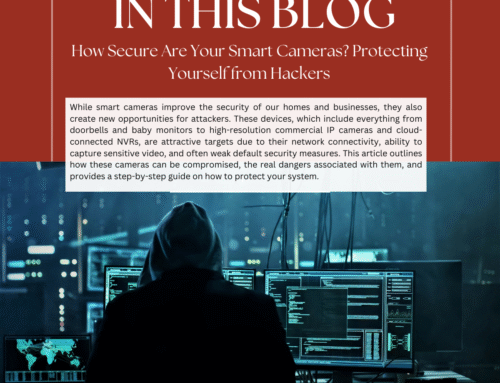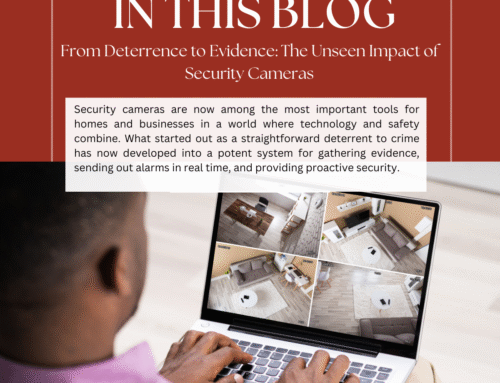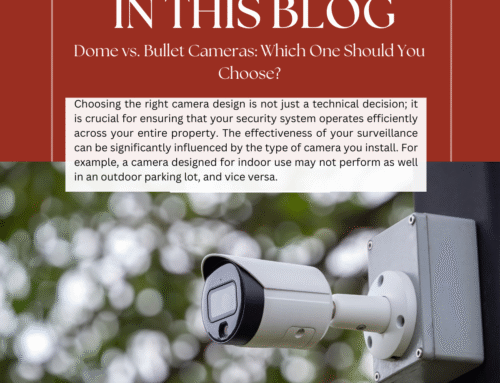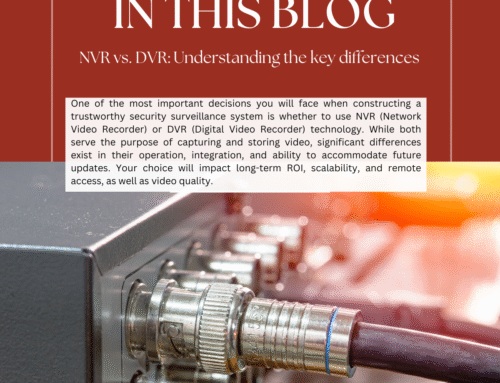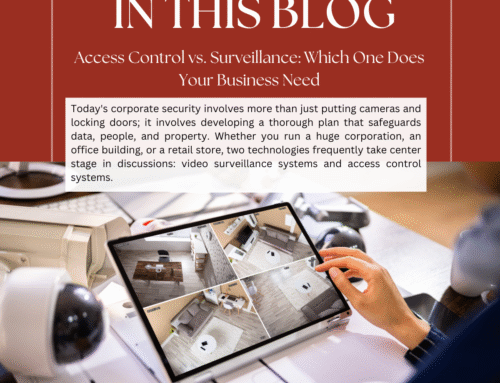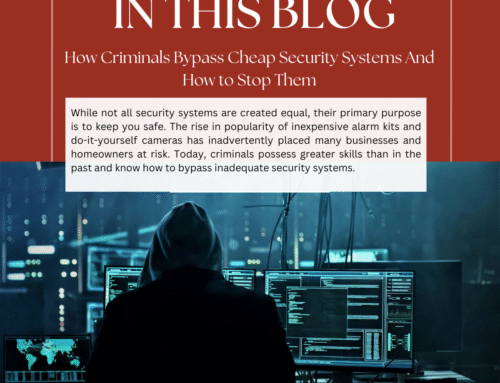Understanding Night Vision and Motion Detection in Security Cameras
Understanding Night Vision and Motion Detection in Security Cameras
Security cameras play a crucial role in modern surveillance across various settings, including public spaces, commercial establishments, residential areas, and industrial sites. Whether you are monitoring a warehouse in Colorado Springs, a retail store in Boulder, or a home in Denver, security cameras have become fundamental to ensuring safety. Two highly sought-after features are motion detection and night vision. These technologies work together effectively: motion detection captures events and triggers alarms only when significant activity occurs, while night vision enables the camera to function in low-light conditions.
Understanding how these features work, along with their limitations, can assist businesses and homeowners in comparing different security systems or planning new installations, ultimately saving time, money, and frustration.
How Night Vision Works
Security cameras can’t depend solely on visible light; a standard sensor would display a dark screen at night or in dimly lit hallways. Infrared (IR) night vision can help with this. Most modern cameras feature arrays of infrared LEDs that emit light invisible to the human eye but detectable by the camera sensor. The camera transforms this invisible light into a crisp, monochromatic image when it strikes things.
- IR Range: The typical range of a home camera is between 30 and 100 feet (10 and 30 meters). With higher-power LEDs, commercial-grade systems may reach up to 200 feet (60 meters).
- Low-Light Sensors: High-end versions don’t need to convert to infrared mode to take decent color photographs in almost complete darkness thanks to back-illuminated CMOS or STARVIS sensors.
- Color vs. Black-and-White: “Color night vision” preserves more information, but it typically requires some background illumination.Although it operates in complete darkness, true “IR night vision” produces black-and-white visuals.
The final product is a camera that is consistently helpful. According to Allied Market Research (2024), the global market for night-vision security cameras is growing at a rate of 12% per year, largely due to the increasing adoption of these cameras in homes and small businesses.
How Motion Recognition Operates
Motion detection is an umbrella term encompassing a number of techniques rather than a single technology:
- Pixel Change Algorithms: The camera highlights any notable differences between each video frame and the one before it. This is typical of low-cost Wi-Fi cameras.
- Passive Infrared (PIR) Sensors: These help cut down on false alarms by detecting changes in heat signatures (humans, animals, and vehicles) as opposed to merely movement.
- Higher-end systems use microwave or radar sensors for more precise detection at greater distances.
- AI/Video Analytics: Newer cameras categorize motion using built-in AI, which can discriminate between a person and a car or ignore shadows and waving trees.
Research Highlights and Statistics
- Industry Size: North America is projected to remain a significant growth area for the global video surveillance market, which is anticipated to reach USD 144 billion by 2030 (Statista).
- Break-In Prevention: According to the Department of Criminal Justice at the University of North Carolina at Charlotte, 60% of convicted thieves stated that they avoided a home because of visible cameras or alarms.
- False Alarm Costs: According to Security Sales & Integration (2024), the United States spends USD 1.8 billion a year reacting to false security alarms. Well-tuned motion detection cameras drastically cut down on needless police calls.
- These numbers demonstrate the significance of properly understanding and configuring your cameras.
Trade-offs, difficulties, and false positives
Businesses and households should be aware of the trade-offs associated with even the most sophisticated security cameras that feature motion detection and night vision.
Typical Issues:
False Positives (Superfluous Warnings)
- Created by insects, rain, shifting branches, or abrupt changes in illumination.
- Causes “alert fatigue,” wastes storage, and depletes battery power.
Reduced by the use of AI person/vehicle identification, masking non-critical zones, modifying sensitivity levels, and integrating PIR sensors with video analytics.
Missed events, or false negatives
- It occurs when there is inadequate illumination or motion detection that is overly insensitive.
- Capturing tiny objects or people in deep shadows can be challenging, especially in slow motion.
- Reduced with the right camera placement, sufficient lighting, and adjusted sensitivity.
Restrictions on Night Image Quality
- Grainy or fuzzy video results from weak infrared LEDs, low sensor sensitivity, or poor-quality lenses.
- Motion blur or lag may result from extended exposures.
- Adding ambient infrared lights, regulating exposure, and upgrading to better quality sensors are among the solutions.
Costs, Power, and Storage
- Continuous filming, extended infrared ranges, and high resolution need more energy and storage.
- Controlled with planned infrared utilization, edge storage, effective video codecs, and motion-triggered recording.
Budget and Durability
- More expensive are advanced features like tough housings, AI processing, and thermal imaging.
- Weather factors that might scatter infrared light or harm components include rain, fog, dust, and extremely high or low temperatures.
- Weatherproof housings, IR-transparent glass, consistent upkeep, and sturdy designs can help you safeguard your investment.
How Customers Can Get the Right Features with Security Surveillance System
At Security Surveillance System, we understand that every home and business has unique security needs. Instead of offering a one-size-fits-all solution, we provide security camera systems that come with a variety of features and upgrades. Our team can recommend models and configurations tailored to your specific requirements and budget.
- Adjustable detection zones and sensitivity levels to fit your space and reduce unnecessary notifications
- Motion detection options like PIR, video analytics, or AI-assisted filtering to help reduce false alerts
- Infrared illumination options, including extended-range or dual-wavelength IR LEDs, for better visibility at night
- High-sensitivity image sensors for clearer footage in low-light conditions
- Secure, encrypted data transfer and storage choices to safeguard your recordings
- Weather-resistant housings and long-lasting parts are appropriate for Colorado’s diverse climates.
Whether you’re securing a large business site, a retail store, or a modest home, a security surveillance system can help you create a customized security solution that balances performance, cost-effectiveness, and reliability.
FAQs: Night Vision and Motion Detection
1. What is the range of night vision cameras?
Answer: Commercial-grade devices with strong infrared arrays may see up to 200 feet (60 meters) in darkness, while residential models usually see 30 to 100 feet (10 to 30 meters).
2. Is it possible to detect movements in complete darkness?
Answer: Radar and PIR sensors can detect movement or heat without visible light. However, AI video analytics may require infrared light to categorize objects.
3. How can I reduce the number of false alarms?
Answer: PIR and video analytics can be combined, sensitivity can be changed, and motion “zones” can be set up to disregard objects like trees or roads.
4. Are insects drawn to infrared LEDs?
Answer: Visible light attracts insects more than infrared light. However, frequent cleaning helps prevent false alarms caused by spiders spinning webs close to heated camera housings
5. Are recordings from security cameras safe?
Answer: Secure storage and encrypted transmission are options offered by Security Surveillance System’s suggested methods to shield your video from unwanted access.
6. Will my electricity bill go up because of night vision cameras?
Answer: Although IR LEDs use a little more power, planned IR utilization and motion-triggered recording help to keep consumption under control.
7. Can smart home systems be integrated with night vision cameras?
Answer: Smart locks, alarms, and remote monitoring applications are integrated into various contemporary systems, including those suggested by Security Surveillance System.
In conclusion
Motion detection and night vision are more than just buzzwords; they are vital technologies that ensure your security system operates around the clock. Understanding how these technologies work, the trade-offs they present, and your options can help you make more informed decisions about protecting your property.
Security Surveillance System can help you choose and install the right equipment for your needs, whether you require home security cameras, specialized security solutions, or a comprehensive business installation in Denver, Boulder, or anywhere else in Colorado. Our professionals find the right balance between reliability, performance, and affordability, offering you a system that enhances your surroundings rather than detracts from them.
Schedule a consultation with Security Surveillance System today to learn about the latest advancements in motion detection, night vision, and other cutting-edge security features.




